Organisational Behaviour Report: Influence and Motivation
VerifiedAdded on 2020/12/29
|15
|4596
|460
Report
AI Summary
This report delves into the multifaceted realm of organisational behaviour, examining its influence on individual and team performance within A W (Holdings) Limited, a confectionery packaging company. It explores the impact of organizational politics, culture, and power dynamics on employee behaviour, highlighting both positive and negative influences. The report identifies and analyzes various power structures, including legitimate, reward, coercive, expert, referent, and informational power, and their application within the company. It also discusses Handy's cultural typology model and its relevance to A W Holdings. Furthermore, the report examines motivational theories, such as Maslow's Hierarchy of Needs and Herzberg's Two-Factor Theory, and their application in achieving organizational goals. It also explores the characteristics of effective and ineffective teams, providing insights into fostering a productive work environment. Finally, the report touches upon key concepts and philosophies of organisational behaviour, offering a comprehensive understanding of the subject.
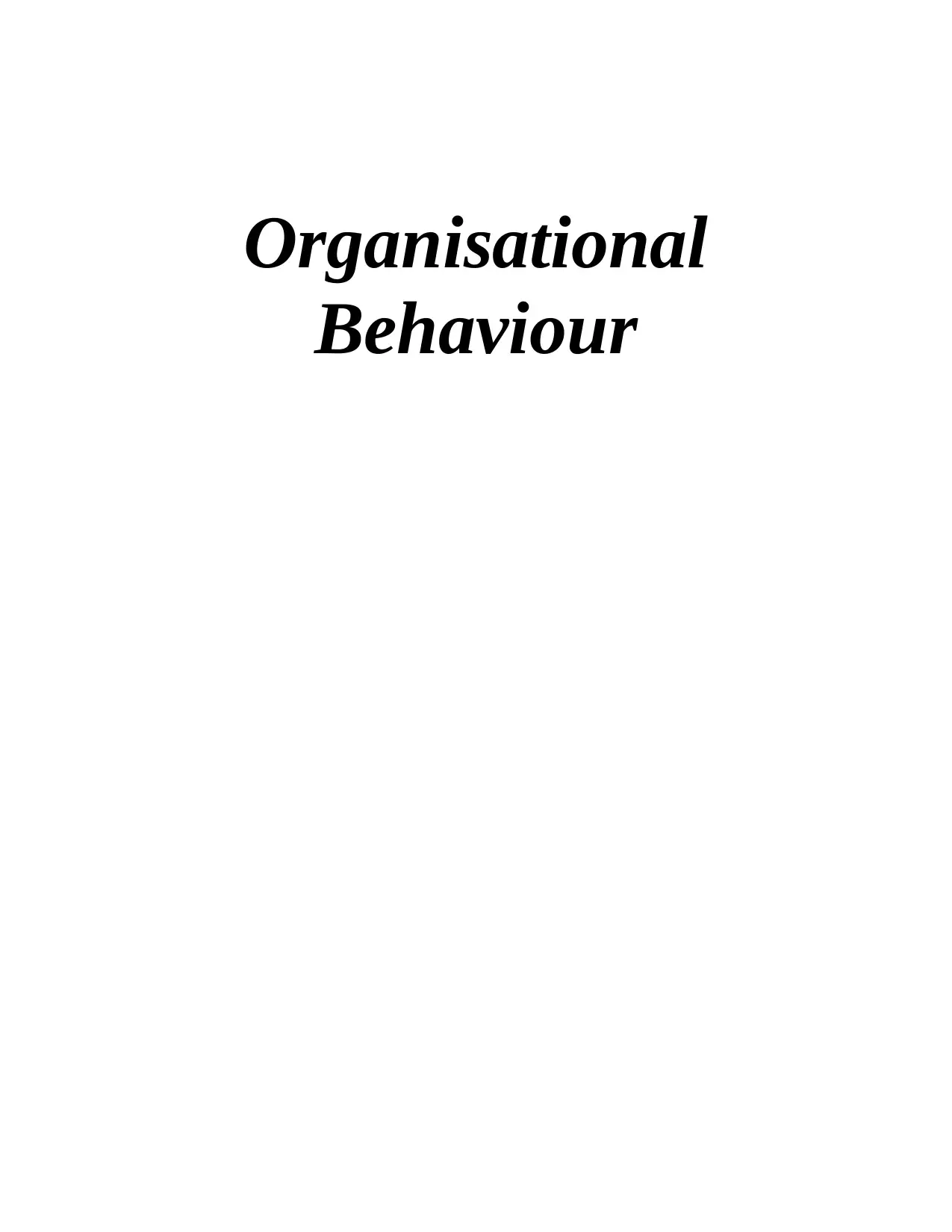
Organisational
Behaviour
Behaviour
Paraphrase This Document
Need a fresh take? Get an instant paraphrase of this document with our AI Paraphraser
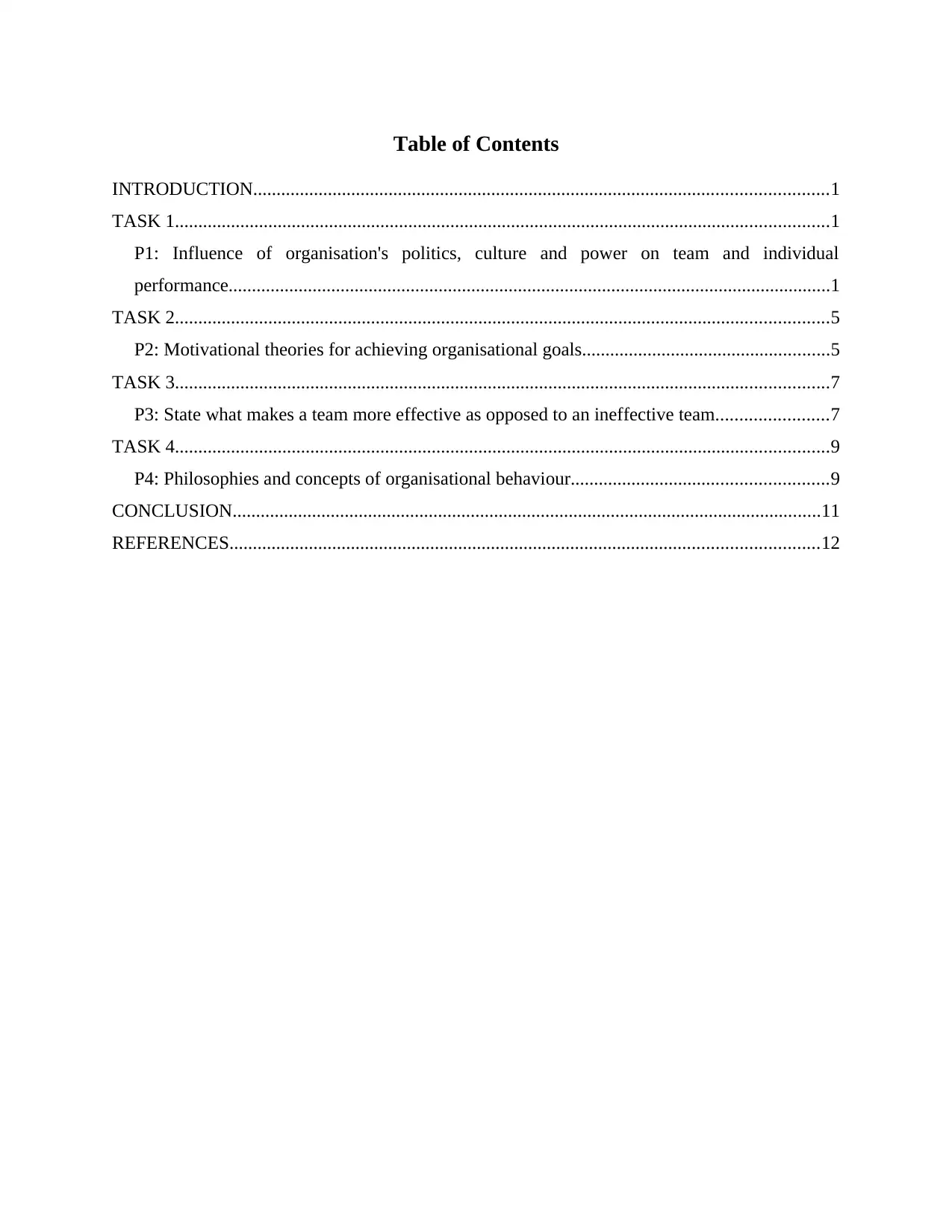
Table of Contents
INTRODUCTION...........................................................................................................................1
TASK 1............................................................................................................................................1
P1: Influence of organisation's politics, culture and power on team and individual
performance.................................................................................................................................1
TASK 2............................................................................................................................................5
P2: Motivational theories for achieving organisational goals.....................................................5
TASK 3............................................................................................................................................7
P3: State what makes a team more effective as opposed to an ineffective team........................7
TASK 4............................................................................................................................................9
P4: Philosophies and concepts of organisational behaviour.......................................................9
CONCLUSION..............................................................................................................................11
REFERENCES..............................................................................................................................12
INTRODUCTION...........................................................................................................................1
TASK 1............................................................................................................................................1
P1: Influence of organisation's politics, culture and power on team and individual
performance.................................................................................................................................1
TASK 2............................................................................................................................................5
P2: Motivational theories for achieving organisational goals.....................................................5
TASK 3............................................................................................................................................7
P3: State what makes a team more effective as opposed to an ineffective team........................7
TASK 4............................................................................................................................................9
P4: Philosophies and concepts of organisational behaviour.......................................................9
CONCLUSION..............................................................................................................................11
REFERENCES..............................................................................................................................12
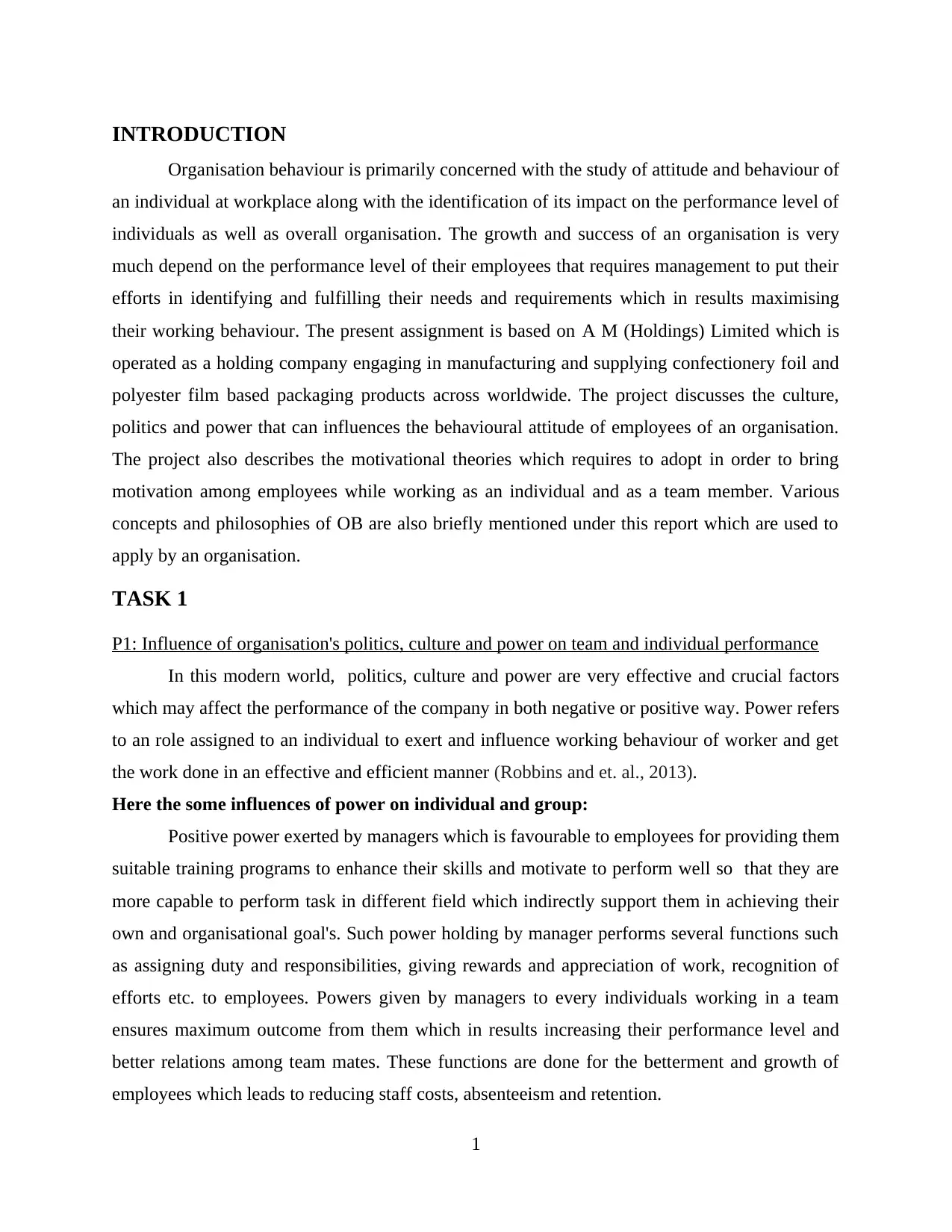
INTRODUCTION
Organisation behaviour is primarily concerned with the study of attitude and behaviour of
an individual at workplace along with the identification of its impact on the performance level of
individuals as well as overall organisation. The growth and success of an organisation is very
much depend on the performance level of their employees that requires management to put their
efforts in identifying and fulfilling their needs and requirements which in results maximising
their working behaviour. The present assignment is based on A M (Holdings) Limited which is
operated as a holding company engaging in manufacturing and supplying confectionery foil and
polyester film based packaging products across worldwide. The project discusses the culture,
politics and power that can influences the behavioural attitude of employees of an organisation.
The project also describes the motivational theories which requires to adopt in order to bring
motivation among employees while working as an individual and as a team member. Various
concepts and philosophies of OB are also briefly mentioned under this report which are used to
apply by an organisation.
TASK 1
P1: Influence of organisation's politics, culture and power on team and individual performance
In this modern world, politics, culture and power are very effective and crucial factors
which may affect the performance of the company in both negative or positive way. Power refers
to an role assigned to an individual to exert and influence working behaviour of worker and get
the work done in an effective and efficient manner (Robbins and et. al., 2013).
Here the some influences of power on individual and group:
Positive power exerted by managers which is favourable to employees for providing them
suitable training programs to enhance their skills and motivate to perform well so that they are
more capable to perform task in different field which indirectly support them in achieving their
own and organisational goal's. Such power holding by manager performs several functions such
as assigning duty and responsibilities, giving rewards and appreciation of work, recognition of
efforts etc. to employees. Powers given by managers to every individuals working in a team
ensures maximum outcome from them which in results increasing their performance level and
better relations among team mates. These functions are done for the betterment and growth of
employees which leads to reducing staff costs, absenteeism and retention.
1
Organisation behaviour is primarily concerned with the study of attitude and behaviour of
an individual at workplace along with the identification of its impact on the performance level of
individuals as well as overall organisation. The growth and success of an organisation is very
much depend on the performance level of their employees that requires management to put their
efforts in identifying and fulfilling their needs and requirements which in results maximising
their working behaviour. The present assignment is based on A M (Holdings) Limited which is
operated as a holding company engaging in manufacturing and supplying confectionery foil and
polyester film based packaging products across worldwide. The project discusses the culture,
politics and power that can influences the behavioural attitude of employees of an organisation.
The project also describes the motivational theories which requires to adopt in order to bring
motivation among employees while working as an individual and as a team member. Various
concepts and philosophies of OB are also briefly mentioned under this report which are used to
apply by an organisation.
TASK 1
P1: Influence of organisation's politics, culture and power on team and individual performance
In this modern world, politics, culture and power are very effective and crucial factors
which may affect the performance of the company in both negative or positive way. Power refers
to an role assigned to an individual to exert and influence working behaviour of worker and get
the work done in an effective and efficient manner (Robbins and et. al., 2013).
Here the some influences of power on individual and group:
Positive power exerted by managers which is favourable to employees for providing them
suitable training programs to enhance their skills and motivate to perform well so that they are
more capable to perform task in different field which indirectly support them in achieving their
own and organisational goal's. Such power holding by manager performs several functions such
as assigning duty and responsibilities, giving rewards and appreciation of work, recognition of
efforts etc. to employees. Powers given by managers to every individuals working in a team
ensures maximum outcome from them which in results increasing their performance level and
better relations among team mates. These functions are done for the betterment and growth of
employees which leads to reducing staff costs, absenteeism and retention.
1
⊘ This is a preview!⊘
Do you want full access?
Subscribe today to unlock all pages.

Trusted by 1+ million students worldwide
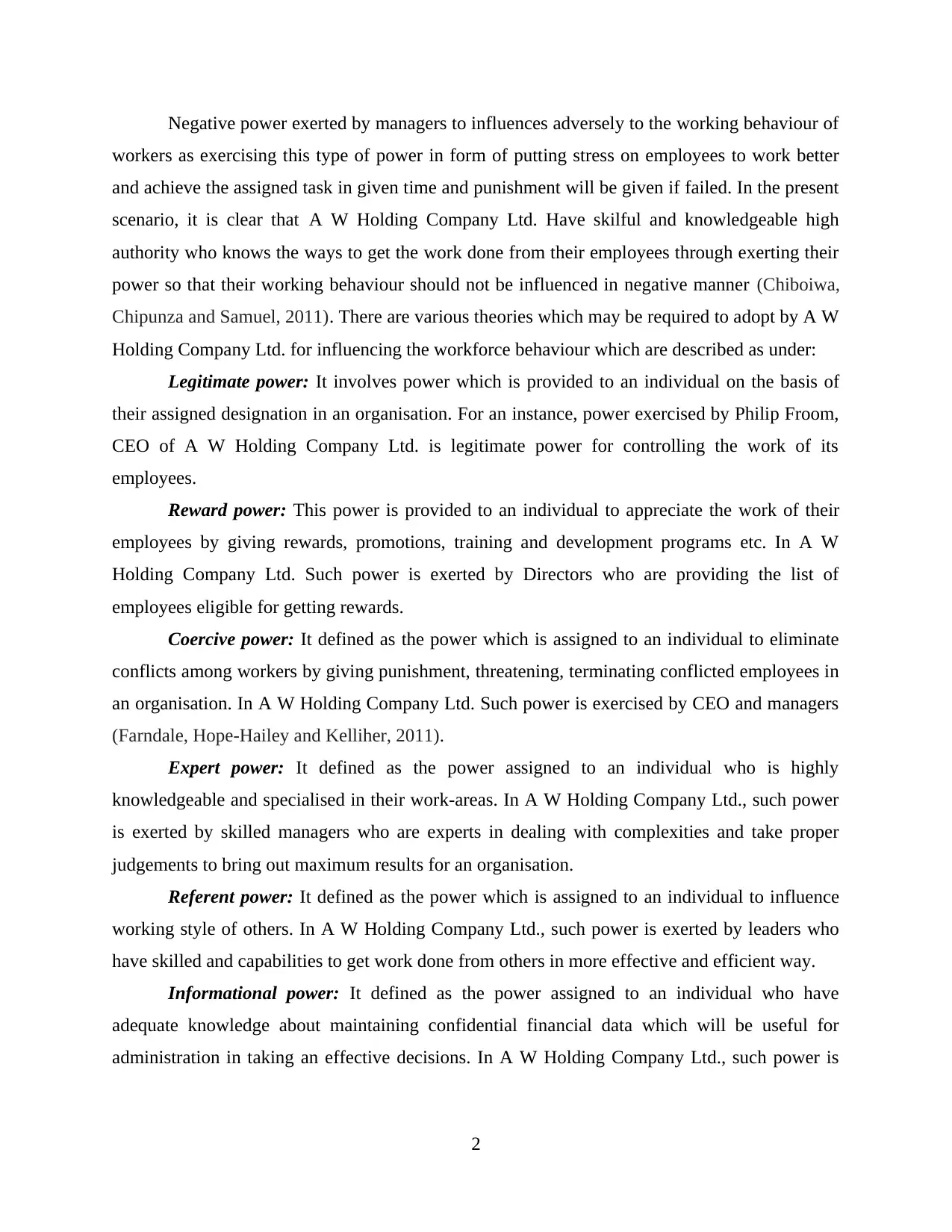
Negative power exerted by managers to influences adversely to the working behaviour of
workers as exercising this type of power in form of putting stress on employees to work better
and achieve the assigned task in given time and punishment will be given if failed. In the present
scenario, it is clear that A W Holding Company Ltd. Have skilful and knowledgeable high
authority who knows the ways to get the work done from their employees through exerting their
power so that their working behaviour should not be influenced in negative manner (Chiboiwa,
Chipunza and Samuel, 2011). There are various theories which may be required to adopt by A W
Holding Company Ltd. for influencing the workforce behaviour which are described as under:
Legitimate power: It involves power which is provided to an individual on the basis of
their assigned designation in an organisation. For an instance, power exercised by Philip Froom,
CEO of A W Holding Company Ltd. is legitimate power for controlling the work of its
employees.
Reward power: This power is provided to an individual to appreciate the work of their
employees by giving rewards, promotions, training and development programs etc. In A W
Holding Company Ltd. Such power is exerted by Directors who are providing the list of
employees eligible for getting rewards.
Coercive power: It defined as the power which is assigned to an individual to eliminate
conflicts among workers by giving punishment, threatening, terminating conflicted employees in
an organisation. In A W Holding Company Ltd. Such power is exercised by CEO and managers
(Farndale, Hope-Hailey and Kelliher, 2011).
Expert power: It defined as the power assigned to an individual who is highly
knowledgeable and specialised in their work-areas. In A W Holding Company Ltd., such power
is exerted by skilled managers who are experts in dealing with complexities and take proper
judgements to bring out maximum results for an organisation.
Referent power: It defined as the power which is assigned to an individual to influence
working style of others. In A W Holding Company Ltd., such power is exerted by leaders who
have skilled and capabilities to get work done from others in more effective and efficient way.
Informational power: It defined as the power assigned to an individual who have
adequate knowledge about maintaining confidential financial data which will be useful for
administration in taking an effective decisions. In A W Holding Company Ltd., such power is
2
workers as exercising this type of power in form of putting stress on employees to work better
and achieve the assigned task in given time and punishment will be given if failed. In the present
scenario, it is clear that A W Holding Company Ltd. Have skilful and knowledgeable high
authority who knows the ways to get the work done from their employees through exerting their
power so that their working behaviour should not be influenced in negative manner (Chiboiwa,
Chipunza and Samuel, 2011). There are various theories which may be required to adopt by A W
Holding Company Ltd. for influencing the workforce behaviour which are described as under:
Legitimate power: It involves power which is provided to an individual on the basis of
their assigned designation in an organisation. For an instance, power exercised by Philip Froom,
CEO of A W Holding Company Ltd. is legitimate power for controlling the work of its
employees.
Reward power: This power is provided to an individual to appreciate the work of their
employees by giving rewards, promotions, training and development programs etc. In A W
Holding Company Ltd. Such power is exerted by Directors who are providing the list of
employees eligible for getting rewards.
Coercive power: It defined as the power which is assigned to an individual to eliminate
conflicts among workers by giving punishment, threatening, terminating conflicted employees in
an organisation. In A W Holding Company Ltd. Such power is exercised by CEO and managers
(Farndale, Hope-Hailey and Kelliher, 2011).
Expert power: It defined as the power assigned to an individual who is highly
knowledgeable and specialised in their work-areas. In A W Holding Company Ltd., such power
is exerted by skilled managers who are experts in dealing with complexities and take proper
judgements to bring out maximum results for an organisation.
Referent power: It defined as the power which is assigned to an individual to influence
working style of others. In A W Holding Company Ltd., such power is exerted by leaders who
have skilled and capabilities to get work done from others in more effective and efficient way.
Informational power: It defined as the power assigned to an individual who have
adequate knowledge about maintaining confidential financial data which will be useful for
administration in taking an effective decisions. In A W Holding Company Ltd., such power is
2
Paraphrase This Document
Need a fresh take? Get an instant paraphrase of this document with our AI Paraphraser
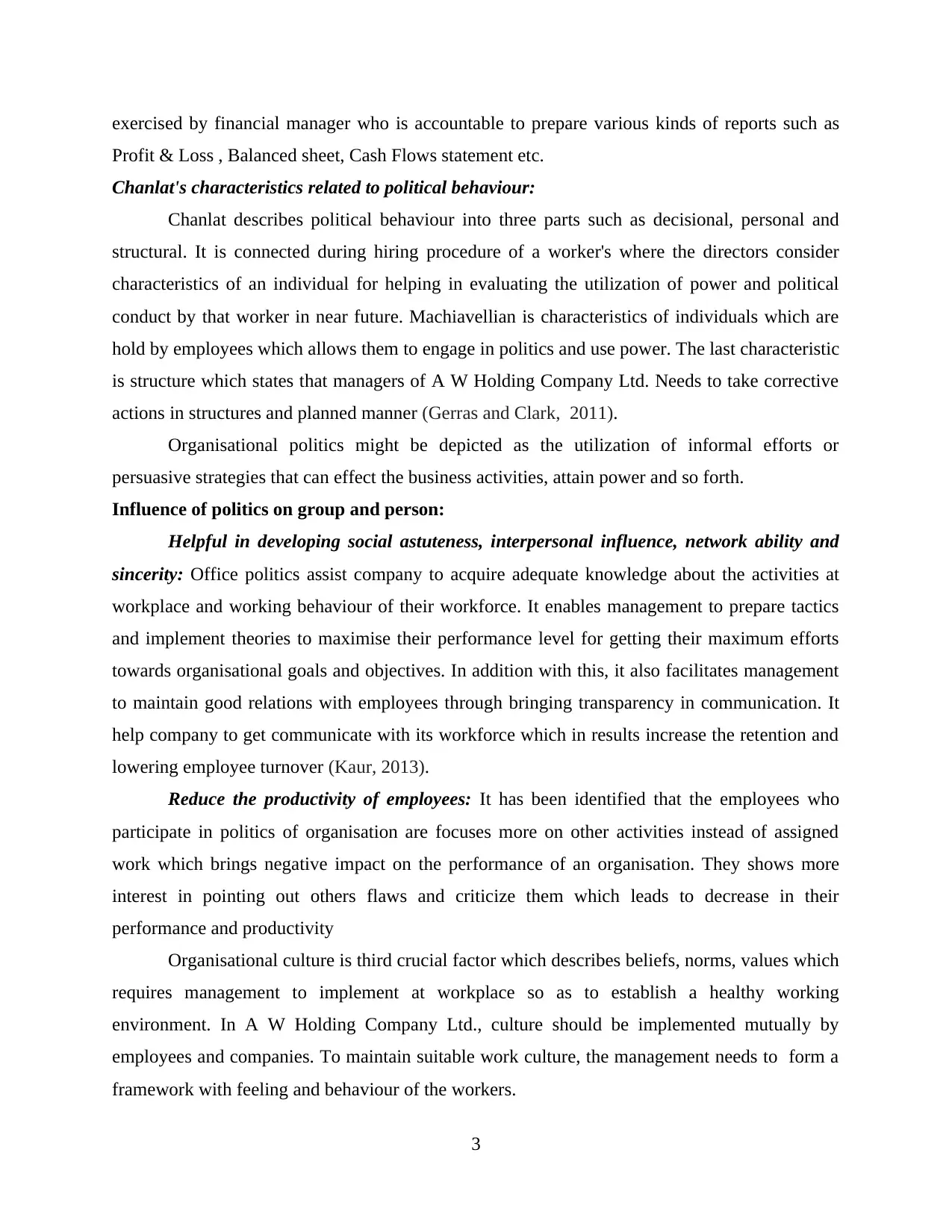
exercised by financial manager who is accountable to prepare various kinds of reports such as
Profit & Loss , Balanced sheet, Cash Flows statement etc.
Chanlat's characteristics related to political behaviour:
Chanlat describes political behaviour into three parts such as decisional, personal and
structural. It is connected during hiring procedure of a worker's where the directors consider
characteristics of an individual for helping in evaluating the utilization of power and political
conduct by that worker in near future. Machiavellian is characteristics of individuals which are
hold by employees which allows them to engage in politics and use power. The last characteristic
is structure which states that managers of A W Holding Company Ltd. Needs to take corrective
actions in structures and planned manner (Gerras and Clark, 2011).
Organisational politics might be depicted as the utilization of informal efforts or
persuasive strategies that can effect the business activities, attain power and so forth.
Influence of politics on group and person:
Helpful in developing social astuteness, interpersonal influence, network ability and
sincerity: Office politics assist company to acquire adequate knowledge about the activities at
workplace and working behaviour of their workforce. It enables management to prepare tactics
and implement theories to maximise their performance level for getting their maximum efforts
towards organisational goals and objectives. In addition with this, it also facilitates management
to maintain good relations with employees through bringing transparency in communication. It
help company to get communicate with its workforce which in results increase the retention and
lowering employee turnover (Kaur, 2013).
Reduce the productivity of employees: It has been identified that the employees who
participate in politics of organisation are focuses more on other activities instead of assigned
work which brings negative impact on the performance of an organisation. They shows more
interest in pointing out others flaws and criticize them which leads to decrease in their
performance and productivity
Organisational culture is third crucial factor which describes beliefs, norms, values which
requires management to implement at workplace so as to establish a healthy working
environment. In A W Holding Company Ltd., culture should be implemented mutually by
employees and companies. To maintain suitable work culture, the management needs to form a
framework with feeling and behaviour of the workers.
3
Profit & Loss , Balanced sheet, Cash Flows statement etc.
Chanlat's characteristics related to political behaviour:
Chanlat describes political behaviour into three parts such as decisional, personal and
structural. It is connected during hiring procedure of a worker's where the directors consider
characteristics of an individual for helping in evaluating the utilization of power and political
conduct by that worker in near future. Machiavellian is characteristics of individuals which are
hold by employees which allows them to engage in politics and use power. The last characteristic
is structure which states that managers of A W Holding Company Ltd. Needs to take corrective
actions in structures and planned manner (Gerras and Clark, 2011).
Organisational politics might be depicted as the utilization of informal efforts or
persuasive strategies that can effect the business activities, attain power and so forth.
Influence of politics on group and person:
Helpful in developing social astuteness, interpersonal influence, network ability and
sincerity: Office politics assist company to acquire adequate knowledge about the activities at
workplace and working behaviour of their workforce. It enables management to prepare tactics
and implement theories to maximise their performance level for getting their maximum efforts
towards organisational goals and objectives. In addition with this, it also facilitates management
to maintain good relations with employees through bringing transparency in communication. It
help company to get communicate with its workforce which in results increase the retention and
lowering employee turnover (Kaur, 2013).
Reduce the productivity of employees: It has been identified that the employees who
participate in politics of organisation are focuses more on other activities instead of assigned
work which brings negative impact on the performance of an organisation. They shows more
interest in pointing out others flaws and criticize them which leads to decrease in their
performance and productivity
Organisational culture is third crucial factor which describes beliefs, norms, values which
requires management to implement at workplace so as to establish a healthy working
environment. In A W Holding Company Ltd., culture should be implemented mutually by
employees and companies. To maintain suitable work culture, the management needs to form a
framework with feeling and behaviour of the workers.
3
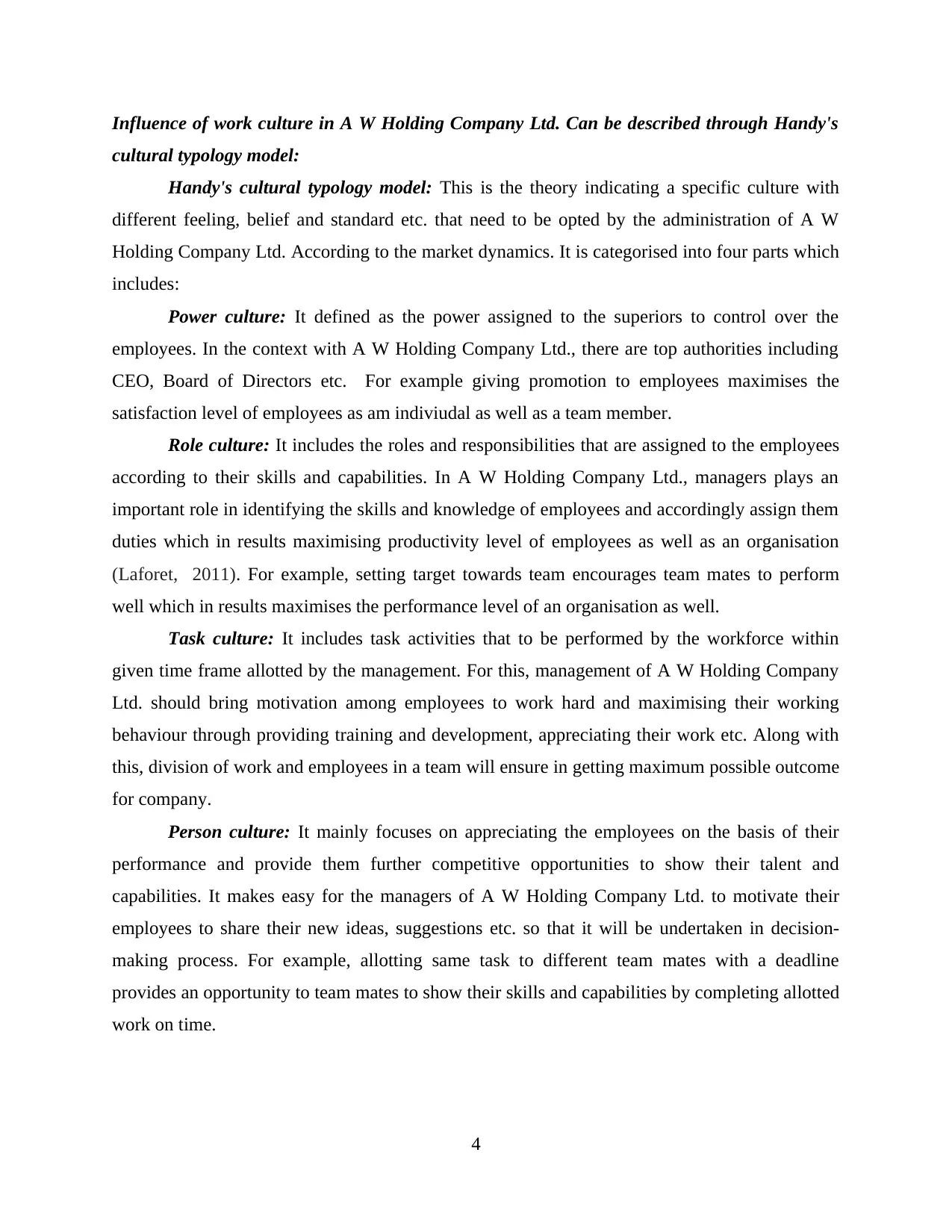
Influence of work culture in A W Holding Company Ltd. Can be described through Handy's
cultural typology model:
Handy's cultural typology model: This is the theory indicating a specific culture with
different feeling, belief and standard etc. that need to be opted by the administration of A W
Holding Company Ltd. According to the market dynamics. It is categorised into four parts which
includes:
Power culture: It defined as the power assigned to the superiors to control over the
employees. In the context with A W Holding Company Ltd., there are top authorities including
CEO, Board of Directors etc. For example giving promotion to employees maximises the
satisfaction level of employees as am indiviudal as well as a team member.
Role culture: It includes the roles and responsibilities that are assigned to the employees
according to their skills and capabilities. In A W Holding Company Ltd., managers plays an
important role in identifying the skills and knowledge of employees and accordingly assign them
duties which in results maximising productivity level of employees as well as an organisation
(Laforet, 2011). For example, setting target towards team encourages team mates to perform
well which in results maximises the performance level of an organisation as well.
Task culture: It includes task activities that to be performed by the workforce within
given time frame allotted by the management. For this, management of A W Holding Company
Ltd. should bring motivation among employees to work hard and maximising their working
behaviour through providing training and development, appreciating their work etc. Along with
this, division of work and employees in a team will ensure in getting maximum possible outcome
for company.
Person culture: It mainly focuses on appreciating the employees on the basis of their
performance and provide them further competitive opportunities to show their talent and
capabilities. It makes easy for the managers of A W Holding Company Ltd. to motivate their
employees to share their new ideas, suggestions etc. so that it will be undertaken in decision-
making process. For example, allotting same task to different team mates with a deadline
provides an opportunity to team mates to show their skills and capabilities by completing allotted
work on time.
4
cultural typology model:
Handy's cultural typology model: This is the theory indicating a specific culture with
different feeling, belief and standard etc. that need to be opted by the administration of A W
Holding Company Ltd. According to the market dynamics. It is categorised into four parts which
includes:
Power culture: It defined as the power assigned to the superiors to control over the
employees. In the context with A W Holding Company Ltd., there are top authorities including
CEO, Board of Directors etc. For example giving promotion to employees maximises the
satisfaction level of employees as am indiviudal as well as a team member.
Role culture: It includes the roles and responsibilities that are assigned to the employees
according to their skills and capabilities. In A W Holding Company Ltd., managers plays an
important role in identifying the skills and knowledge of employees and accordingly assign them
duties which in results maximising productivity level of employees as well as an organisation
(Laforet, 2011). For example, setting target towards team encourages team mates to perform
well which in results maximises the performance level of an organisation as well.
Task culture: It includes task activities that to be performed by the workforce within
given time frame allotted by the management. For this, management of A W Holding Company
Ltd. should bring motivation among employees to work hard and maximising their working
behaviour through providing training and development, appreciating their work etc. Along with
this, division of work and employees in a team will ensure in getting maximum possible outcome
for company.
Person culture: It mainly focuses on appreciating the employees on the basis of their
performance and provide them further competitive opportunities to show their talent and
capabilities. It makes easy for the managers of A W Holding Company Ltd. to motivate their
employees to share their new ideas, suggestions etc. so that it will be undertaken in decision-
making process. For example, allotting same task to different team mates with a deadline
provides an opportunity to team mates to show their skills and capabilities by completing allotted
work on time.
4
⊘ This is a preview!⊘
Do you want full access?
Subscribe today to unlock all pages.

Trusted by 1+ million students worldwide
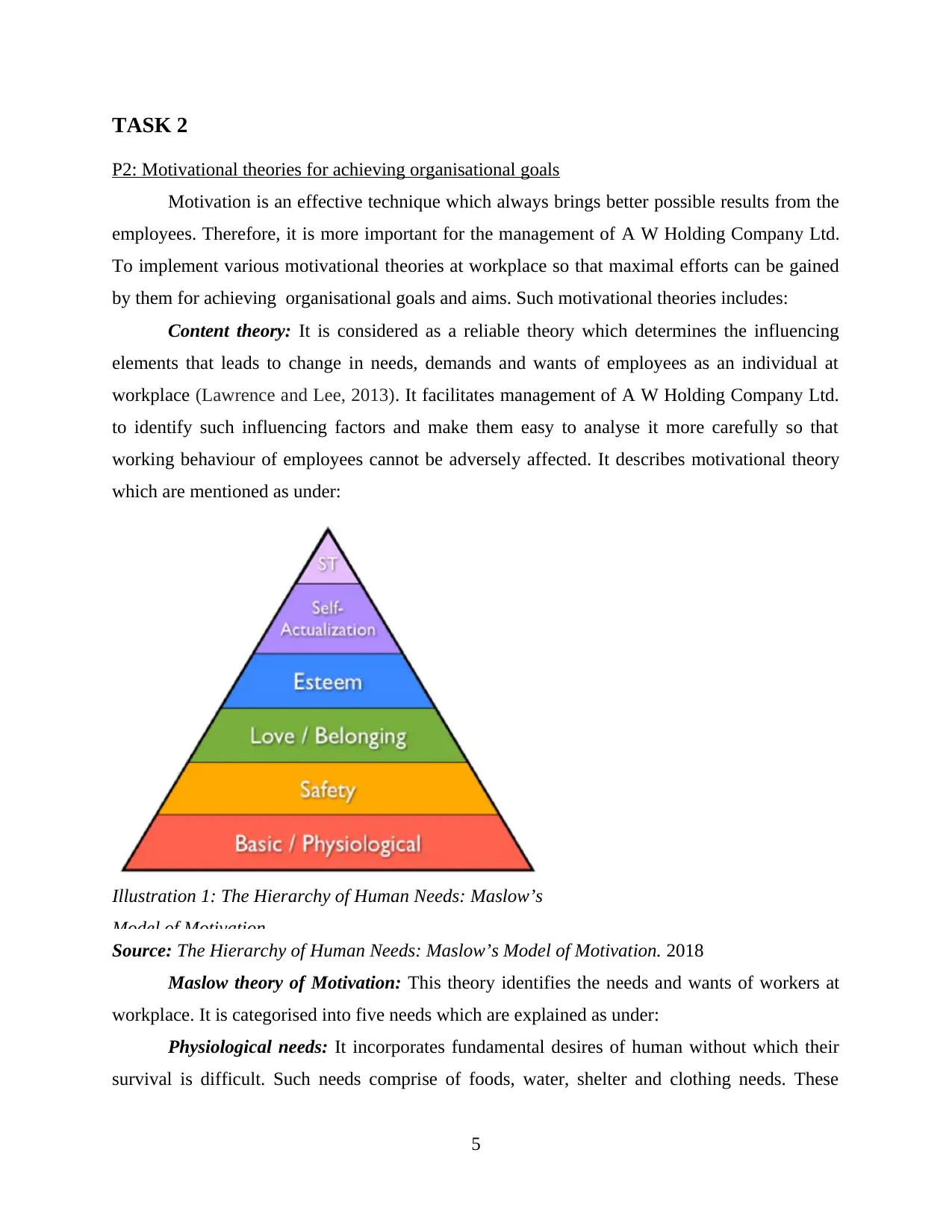
TASK 2
P2: Motivational theories for achieving organisational goals
Motivation is an effective technique which always brings better possible results from the
employees. Therefore, it is more important for the management of A W Holding Company Ltd.
To implement various motivational theories at workplace so that maximal efforts can be gained
by them for achieving organisational goals and aims. Such motivational theories includes:
Content theory: It is considered as a reliable theory which determines the influencing
elements that leads to change in needs, demands and wants of employees as an individual at
workplace (Lawrence and Lee, 2013). It facilitates management of A W Holding Company Ltd.
to identify such influencing factors and make them easy to analyse it more carefully so that
working behaviour of employees cannot be adversely affected. It describes motivational theory
which are mentioned as under:
Illustration 1: The Hierarchy of Human Needs: Maslow’s
Model of Motivation
Source: The Hierarchy of Human Needs: Maslow’s Model of Motivation. 2018
Maslow theory of Motivation: This theory identifies the needs and wants of workers at
workplace. It is categorised into five needs which are explained as under:
Physiological needs: It incorporates fundamental desires of human without which their
survival is difficult. Such needs comprise of foods, water, shelter and clothing needs. These
5
P2: Motivational theories for achieving organisational goals
Motivation is an effective technique which always brings better possible results from the
employees. Therefore, it is more important for the management of A W Holding Company Ltd.
To implement various motivational theories at workplace so that maximal efforts can be gained
by them for achieving organisational goals and aims. Such motivational theories includes:
Content theory: It is considered as a reliable theory which determines the influencing
elements that leads to change in needs, demands and wants of employees as an individual at
workplace (Lawrence and Lee, 2013). It facilitates management of A W Holding Company Ltd.
to identify such influencing factors and make them easy to analyse it more carefully so that
working behaviour of employees cannot be adversely affected. It describes motivational theory
which are mentioned as under:
Illustration 1: The Hierarchy of Human Needs: Maslow’s
Model of Motivation
Source: The Hierarchy of Human Needs: Maslow’s Model of Motivation. 2018
Maslow theory of Motivation: This theory identifies the needs and wants of workers at
workplace. It is categorised into five needs which are explained as under:
Physiological needs: It incorporates fundamental desires of human without which their
survival is difficult. Such needs comprise of foods, water, shelter and clothing needs. These
5
Paraphrase This Document
Need a fresh take? Get an instant paraphrase of this document with our AI Paraphraser
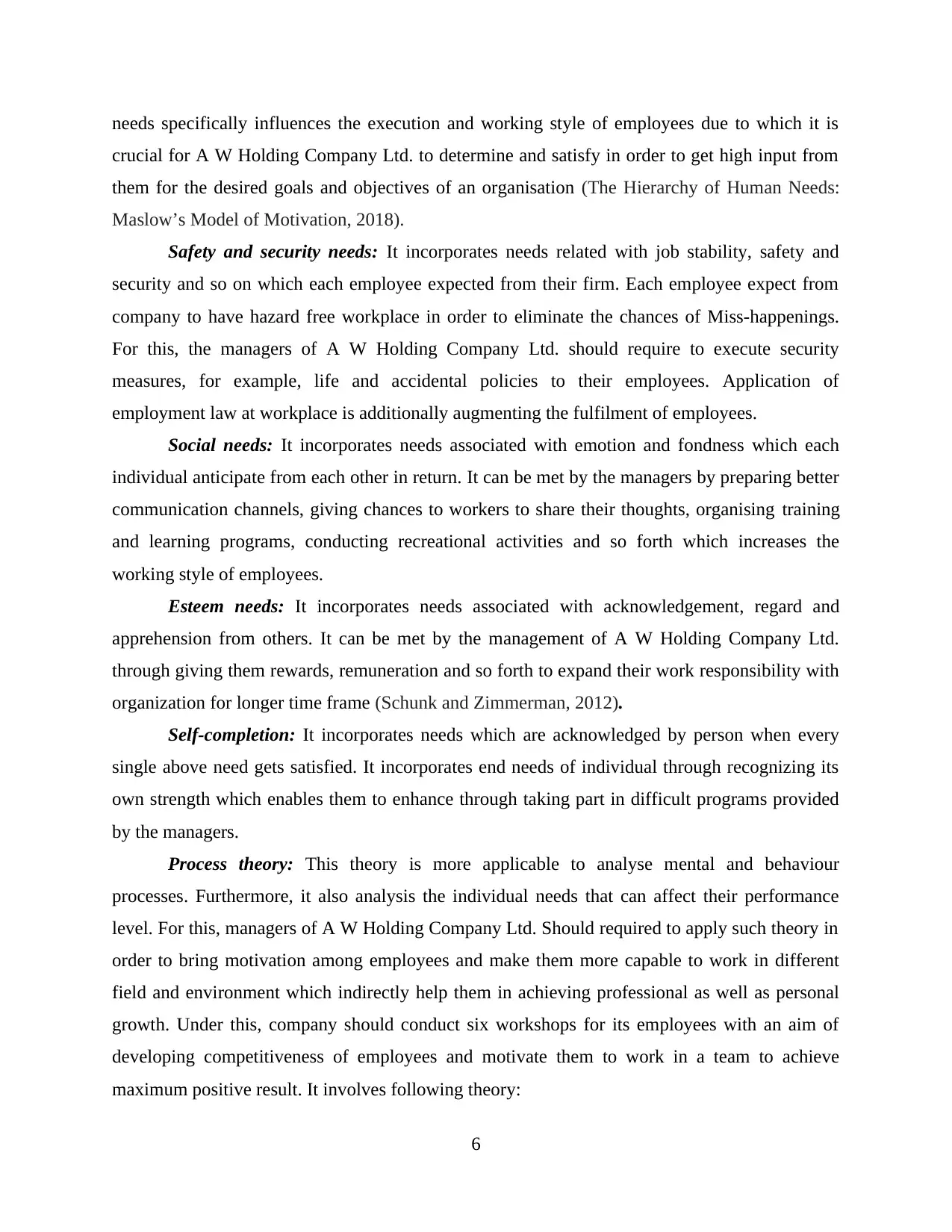
needs specifically influences the execution and working style of employees due to which it is
crucial for A W Holding Company Ltd. to determine and satisfy in order to get high input from
them for the desired goals and objectives of an organisation (The Hierarchy of Human Needs:
Maslow’s Model of Motivation, 2018).
Safety and security needs: It incorporates needs related with job stability, safety and
security and so on which each employee expected from their firm. Each employee expect from
company to have hazard free workplace in order to eliminate the chances of Miss-happenings.
For this, the managers of A W Holding Company Ltd. should require to execute security
measures, for example, life and accidental policies to their employees. Application of
employment law at workplace is additionally augmenting the fulfilment of employees.
Social needs: It incorporates needs associated with emotion and fondness which each
individual anticipate from each other in return. It can be met by the managers by preparing better
communication channels, giving chances to workers to share their thoughts, organising training
and learning programs, conducting recreational activities and so forth which increases the
working style of employees.
Esteem needs: It incorporates needs associated with acknowledgement, regard and
apprehension from others. It can be met by the management of A W Holding Company Ltd.
through giving them rewards, remuneration and so forth to expand their work responsibility with
organization for longer time frame (Schunk and Zimmerman, 2012).
Self-completion: It incorporates needs which are acknowledged by person when every
single above need gets satisfied. It incorporates end needs of individual through recognizing its
own strength which enables them to enhance through taking part in difficult programs provided
by the managers.
Process theory: This theory is more applicable to analyse mental and behaviour
processes. Furthermore, it also analysis the individual needs that can affect their performance
level. For this, managers of A W Holding Company Ltd. Should required to apply such theory in
order to bring motivation among employees and make them more capable to work in different
field and environment which indirectly help them in achieving professional as well as personal
growth. Under this, company should conduct six workshops for its employees with an aim of
developing competitiveness of employees and motivate them to work in a team to achieve
maximum positive result. It involves following theory:
6
crucial for A W Holding Company Ltd. to determine and satisfy in order to get high input from
them for the desired goals and objectives of an organisation (The Hierarchy of Human Needs:
Maslow’s Model of Motivation, 2018).
Safety and security needs: It incorporates needs related with job stability, safety and
security and so on which each employee expected from their firm. Each employee expect from
company to have hazard free workplace in order to eliminate the chances of Miss-happenings.
For this, the managers of A W Holding Company Ltd. should require to execute security
measures, for example, life and accidental policies to their employees. Application of
employment law at workplace is additionally augmenting the fulfilment of employees.
Social needs: It incorporates needs associated with emotion and fondness which each
individual anticipate from each other in return. It can be met by the managers by preparing better
communication channels, giving chances to workers to share their thoughts, organising training
and learning programs, conducting recreational activities and so forth which increases the
working style of employees.
Esteem needs: It incorporates needs associated with acknowledgement, regard and
apprehension from others. It can be met by the management of A W Holding Company Ltd.
through giving them rewards, remuneration and so forth to expand their work responsibility with
organization for longer time frame (Schunk and Zimmerman, 2012).
Self-completion: It incorporates needs which are acknowledged by person when every
single above need gets satisfied. It incorporates end needs of individual through recognizing its
own strength which enables them to enhance through taking part in difficult programs provided
by the managers.
Process theory: This theory is more applicable to analyse mental and behaviour
processes. Furthermore, it also analysis the individual needs that can affect their performance
level. For this, managers of A W Holding Company Ltd. Should required to apply such theory in
order to bring motivation among employees and make them more capable to work in different
field and environment which indirectly help them in achieving professional as well as personal
growth. Under this, company should conduct six workshops for its employees with an aim of
developing competitiveness of employees and motivate them to work in a team to achieve
maximum positive result. It involves following theory:
6
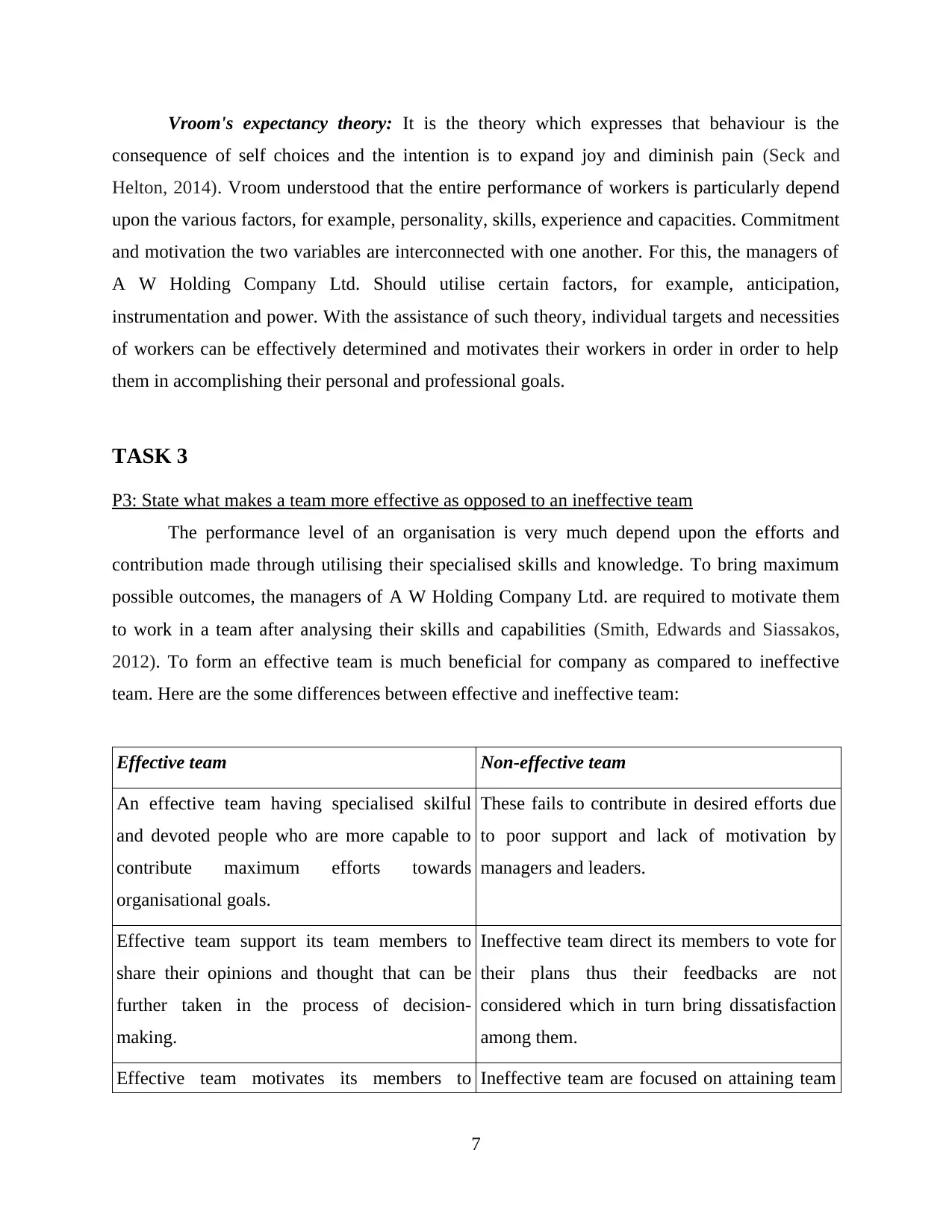
Vroom's expectancy theory: It is the theory which expresses that behaviour is the
consequence of self choices and the intention is to expand joy and diminish pain (Seck and
Helton, 2014). Vroom understood that the entire performance of workers is particularly depend
upon the various factors, for example, personality, skills, experience and capacities. Commitment
and motivation the two variables are interconnected with one another. For this, the managers of
A W Holding Company Ltd. Should utilise certain factors, for example, anticipation,
instrumentation and power. With the assistance of such theory, individual targets and necessities
of workers can be effectively determined and motivates their workers in order in order to help
them in accomplishing their personal and professional goals.
TASK 3
P3: State what makes a team more effective as opposed to an ineffective team
The performance level of an organisation is very much depend upon the efforts and
contribution made through utilising their specialised skills and knowledge. To bring maximum
possible outcomes, the managers of A W Holding Company Ltd. are required to motivate them
to work in a team after analysing their skills and capabilities (Smith, Edwards and Siassakos,
2012). To form an effective team is much beneficial for company as compared to ineffective
team. Here are the some differences between effective and ineffective team:
Effective team Non-effective team
An effective team having specialised skilful
and devoted people who are more capable to
contribute maximum efforts towards
organisational goals.
These fails to contribute in desired efforts due
to poor support and lack of motivation by
managers and leaders.
Effective team support its team members to
share their opinions and thought that can be
further taken in the process of decision-
making.
Ineffective team direct its members to vote for
their plans thus their feedbacks are not
considered which in turn bring dissatisfaction
among them.
Effective team motivates its members to Ineffective team are focused on attaining team
7
consequence of self choices and the intention is to expand joy and diminish pain (Seck and
Helton, 2014). Vroom understood that the entire performance of workers is particularly depend
upon the various factors, for example, personality, skills, experience and capacities. Commitment
and motivation the two variables are interconnected with one another. For this, the managers of
A W Holding Company Ltd. Should utilise certain factors, for example, anticipation,
instrumentation and power. With the assistance of such theory, individual targets and necessities
of workers can be effectively determined and motivates their workers in order in order to help
them in accomplishing their personal and professional goals.
TASK 3
P3: State what makes a team more effective as opposed to an ineffective team
The performance level of an organisation is very much depend upon the efforts and
contribution made through utilising their specialised skills and knowledge. To bring maximum
possible outcomes, the managers of A W Holding Company Ltd. are required to motivate them
to work in a team after analysing their skills and capabilities (Smith, Edwards and Siassakos,
2012). To form an effective team is much beneficial for company as compared to ineffective
team. Here are the some differences between effective and ineffective team:
Effective team Non-effective team
An effective team having specialised skilful
and devoted people who are more capable to
contribute maximum efforts towards
organisational goals.
These fails to contribute in desired efforts due
to poor support and lack of motivation by
managers and leaders.
Effective team support its team members to
share their opinions and thought that can be
further taken in the process of decision-
making.
Ineffective team direct its members to vote for
their plans thus their feedbacks are not
considered which in turn bring dissatisfaction
among them.
Effective team motivates its members to Ineffective team are focused on attaining team
7
⊘ This is a preview!⊘
Do you want full access?
Subscribe today to unlock all pages.

Trusted by 1+ million students worldwide
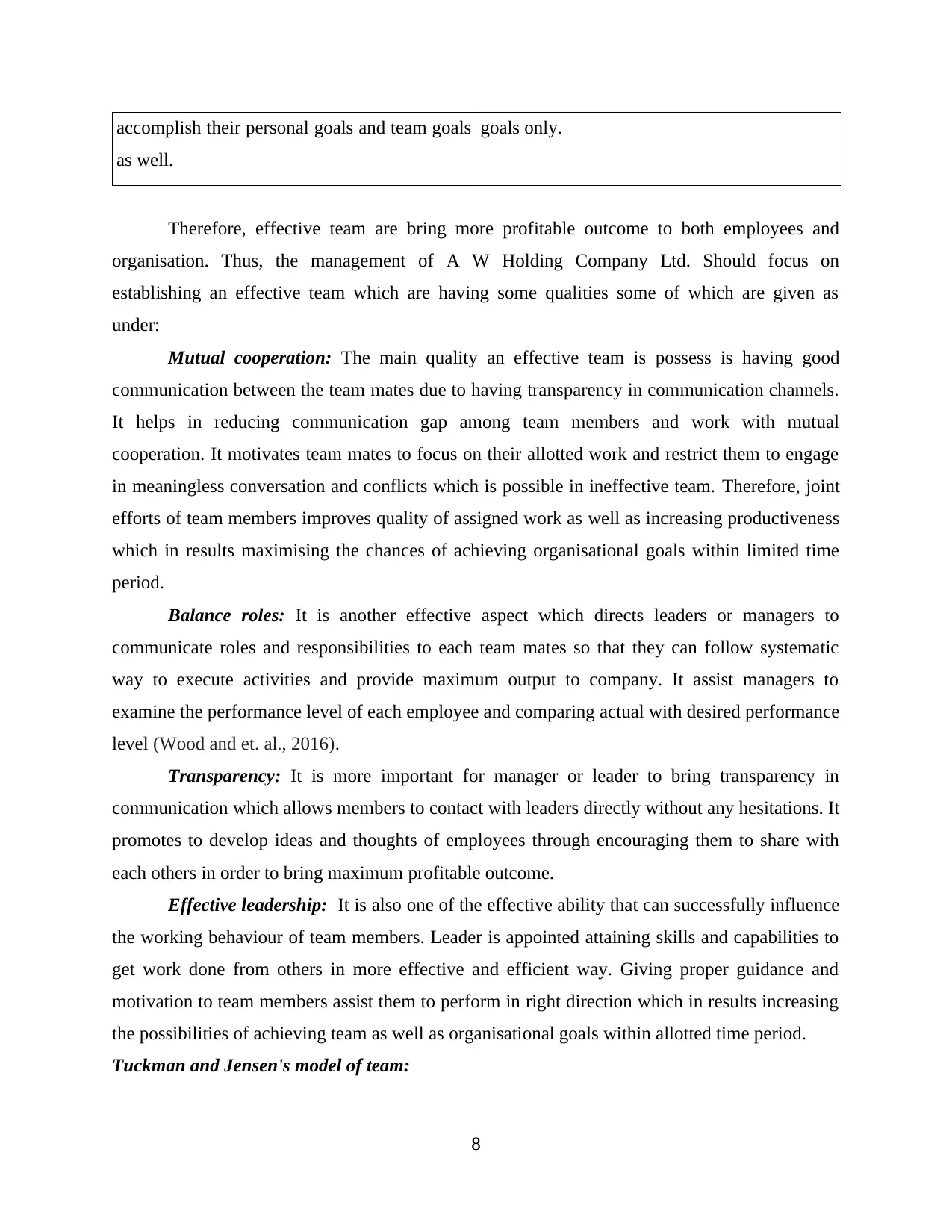
accomplish their personal goals and team goals
as well.
goals only.
Therefore, effective team are bring more profitable outcome to both employees and
organisation. Thus, the management of A W Holding Company Ltd. Should focus on
establishing an effective team which are having some qualities some of which are given as
under:
Mutual cooperation: The main quality an effective team is possess is having good
communication between the team mates due to having transparency in communication channels.
It helps in reducing communication gap among team members and work with mutual
cooperation. It motivates team mates to focus on their allotted work and restrict them to engage
in meaningless conversation and conflicts which is possible in ineffective team. Therefore, joint
efforts of team members improves quality of assigned work as well as increasing productiveness
which in results maximising the chances of achieving organisational goals within limited time
period.
Balance roles: It is another effective aspect which directs leaders or managers to
communicate roles and responsibilities to each team mates so that they can follow systematic
way to execute activities and provide maximum output to company. It assist managers to
examine the performance level of each employee and comparing actual with desired performance
level (Wood and et. al., 2016).
Transparency: It is more important for manager or leader to bring transparency in
communication which allows members to contact with leaders directly without any hesitations. It
promotes to develop ideas and thoughts of employees through encouraging them to share with
each others in order to bring maximum profitable outcome.
Effective leadership: It is also one of the effective ability that can successfully influence
the working behaviour of team members. Leader is appointed attaining skills and capabilities to
get work done from others in more effective and efficient way. Giving proper guidance and
motivation to team members assist them to perform in right direction which in results increasing
the possibilities of achieving team as well as organisational goals within allotted time period.
Tuckman and Jensen's model of team:
8
as well.
goals only.
Therefore, effective team are bring more profitable outcome to both employees and
organisation. Thus, the management of A W Holding Company Ltd. Should focus on
establishing an effective team which are having some qualities some of which are given as
under:
Mutual cooperation: The main quality an effective team is possess is having good
communication between the team mates due to having transparency in communication channels.
It helps in reducing communication gap among team members and work with mutual
cooperation. It motivates team mates to focus on their allotted work and restrict them to engage
in meaningless conversation and conflicts which is possible in ineffective team. Therefore, joint
efforts of team members improves quality of assigned work as well as increasing productiveness
which in results maximising the chances of achieving organisational goals within limited time
period.
Balance roles: It is another effective aspect which directs leaders or managers to
communicate roles and responsibilities to each team mates so that they can follow systematic
way to execute activities and provide maximum output to company. It assist managers to
examine the performance level of each employee and comparing actual with desired performance
level (Wood and et. al., 2016).
Transparency: It is more important for manager or leader to bring transparency in
communication which allows members to contact with leaders directly without any hesitations. It
promotes to develop ideas and thoughts of employees through encouraging them to share with
each others in order to bring maximum profitable outcome.
Effective leadership: It is also one of the effective ability that can successfully influence
the working behaviour of team members. Leader is appointed attaining skills and capabilities to
get work done from others in more effective and efficient way. Giving proper guidance and
motivation to team members assist them to perform in right direction which in results increasing
the possibilities of achieving team as well as organisational goals within allotted time period.
Tuckman and Jensen's model of team:
8
Paraphrase This Document
Need a fresh take? Get an instant paraphrase of this document with our AI Paraphraser
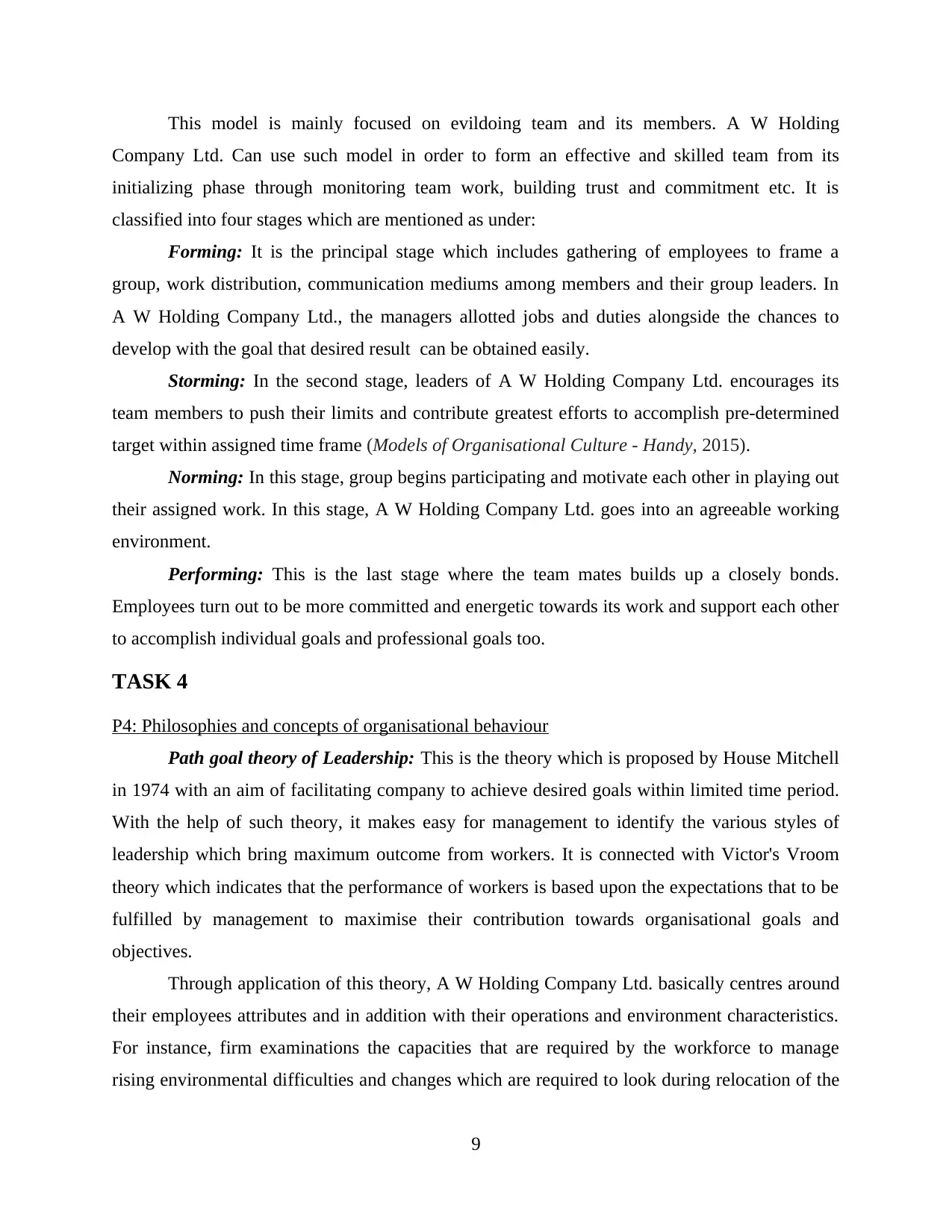
This model is mainly focused on evildoing team and its members. A W Holding
Company Ltd. Can use such model in order to form an effective and skilled team from its
initializing phase through monitoring team work, building trust and commitment etc. It is
classified into four stages which are mentioned as under:
Forming: It is the principal stage which includes gathering of employees to frame a
group, work distribution, communication mediums among members and their group leaders. In
A W Holding Company Ltd., the managers allotted jobs and duties alongside the chances to
develop with the goal that desired result can be obtained easily.
Storming: In the second stage, leaders of A W Holding Company Ltd. encourages its
team members to push their limits and contribute greatest efforts to accomplish pre-determined
target within assigned time frame (Models of Organisational Culture - Handy, 2015).
Norming: In this stage, group begins participating and motivate each other in playing out
their assigned work. In this stage, A W Holding Company Ltd. goes into an agreeable working
environment.
Performing: This is the last stage where the team mates builds up a closely bonds.
Employees turn out to be more committed and energetic towards its work and support each other
to accomplish individual goals and professional goals too.
TASK 4
P4: Philosophies and concepts of organisational behaviour
Path goal theory of Leadership: This is the theory which is proposed by House Mitchell
in 1974 with an aim of facilitating company to achieve desired goals within limited time period.
With the help of such theory, it makes easy for management to identify the various styles of
leadership which bring maximum outcome from workers. It is connected with Victor's Vroom
theory which indicates that the performance of workers is based upon the expectations that to be
fulfilled by management to maximise their contribution towards organisational goals and
objectives.
Through application of this theory, A W Holding Company Ltd. basically centres around
their employees attributes and in addition with their operations and environment characteristics.
For instance, firm examinations the capacities that are required by the workforce to manage
rising environmental difficulties and changes which are required to look during relocation of the
9
Company Ltd. Can use such model in order to form an effective and skilled team from its
initializing phase through monitoring team work, building trust and commitment etc. It is
classified into four stages which are mentioned as under:
Forming: It is the principal stage which includes gathering of employees to frame a
group, work distribution, communication mediums among members and their group leaders. In
A W Holding Company Ltd., the managers allotted jobs and duties alongside the chances to
develop with the goal that desired result can be obtained easily.
Storming: In the second stage, leaders of A W Holding Company Ltd. encourages its
team members to push their limits and contribute greatest efforts to accomplish pre-determined
target within assigned time frame (Models of Organisational Culture - Handy, 2015).
Norming: In this stage, group begins participating and motivate each other in playing out
their assigned work. In this stage, A W Holding Company Ltd. goes into an agreeable working
environment.
Performing: This is the last stage where the team mates builds up a closely bonds.
Employees turn out to be more committed and energetic towards its work and support each other
to accomplish individual goals and professional goals too.
TASK 4
P4: Philosophies and concepts of organisational behaviour
Path goal theory of Leadership: This is the theory which is proposed by House Mitchell
in 1974 with an aim of facilitating company to achieve desired goals within limited time period.
With the help of such theory, it makes easy for management to identify the various styles of
leadership which bring maximum outcome from workers. It is connected with Victor's Vroom
theory which indicates that the performance of workers is based upon the expectations that to be
fulfilled by management to maximise their contribution towards organisational goals and
objectives.
Through application of this theory, A W Holding Company Ltd. basically centres around
their employees attributes and in addition with their operations and environment characteristics.
For instance, firm examinations the capacities that are required by the workforce to manage
rising environmental difficulties and changes which are required to look during relocation of the
9
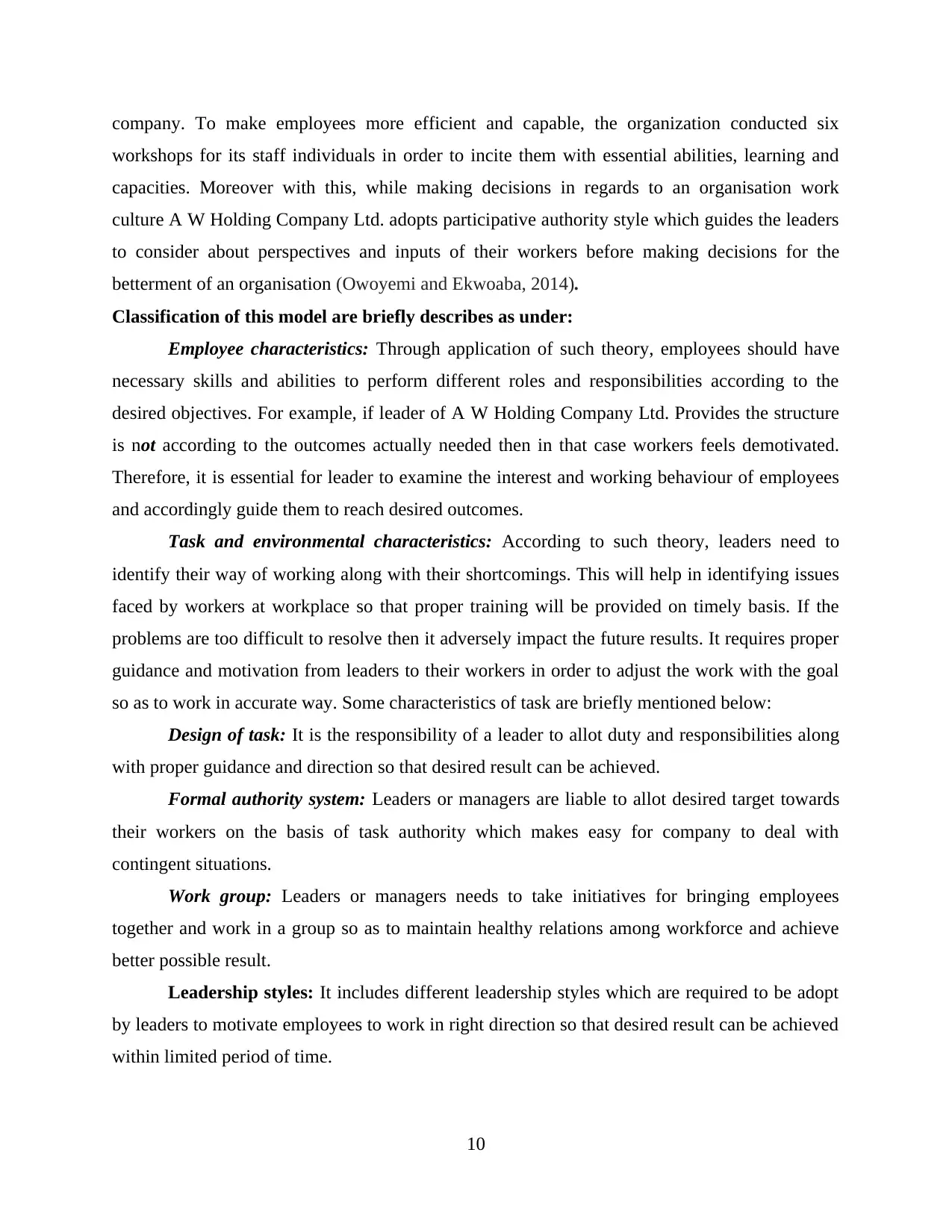
company. To make employees more efficient and capable, the organization conducted six
workshops for its staff individuals in order to incite them with essential abilities, learning and
capacities. Moreover with this, while making decisions in regards to an organisation work
culture A W Holding Company Ltd. adopts participative authority style which guides the leaders
to consider about perspectives and inputs of their workers before making decisions for the
betterment of an organisation (Owoyemi and Ekwoaba, 2014).
Classification of this model are briefly describes as under:
Employee characteristics: Through application of such theory, employees should have
necessary skills and abilities to perform different roles and responsibilities according to the
desired objectives. For example, if leader of A W Holding Company Ltd. Provides the structure
is not according to the outcomes actually needed then in that case workers feels demotivated.
Therefore, it is essential for leader to examine the interest and working behaviour of employees
and accordingly guide them to reach desired outcomes.
Task and environmental characteristics: According to such theory, leaders need to
identify their way of working along with their shortcomings. This will help in identifying issues
faced by workers at workplace so that proper training will be provided on timely basis. If the
problems are too difficult to resolve then it adversely impact the future results. It requires proper
guidance and motivation from leaders to their workers in order to adjust the work with the goal
so as to work in accurate way. Some characteristics of task are briefly mentioned below:
Design of task: It is the responsibility of a leader to allot duty and responsibilities along
with proper guidance and direction so that desired result can be achieved.
Formal authority system: Leaders or managers are liable to allot desired target towards
their workers on the basis of task authority which makes easy for company to deal with
contingent situations.
Work group: Leaders or managers needs to take initiatives for bringing employees
together and work in a group so as to maintain healthy relations among workforce and achieve
better possible result.
Leadership styles: It includes different leadership styles which are required to be adopt
by leaders to motivate employees to work in right direction so that desired result can be achieved
within limited period of time.
10
workshops for its staff individuals in order to incite them with essential abilities, learning and
capacities. Moreover with this, while making decisions in regards to an organisation work
culture A W Holding Company Ltd. adopts participative authority style which guides the leaders
to consider about perspectives and inputs of their workers before making decisions for the
betterment of an organisation (Owoyemi and Ekwoaba, 2014).
Classification of this model are briefly describes as under:
Employee characteristics: Through application of such theory, employees should have
necessary skills and abilities to perform different roles and responsibilities according to the
desired objectives. For example, if leader of A W Holding Company Ltd. Provides the structure
is not according to the outcomes actually needed then in that case workers feels demotivated.
Therefore, it is essential for leader to examine the interest and working behaviour of employees
and accordingly guide them to reach desired outcomes.
Task and environmental characteristics: According to such theory, leaders need to
identify their way of working along with their shortcomings. This will help in identifying issues
faced by workers at workplace so that proper training will be provided on timely basis. If the
problems are too difficult to resolve then it adversely impact the future results. It requires proper
guidance and motivation from leaders to their workers in order to adjust the work with the goal
so as to work in accurate way. Some characteristics of task are briefly mentioned below:
Design of task: It is the responsibility of a leader to allot duty and responsibilities along
with proper guidance and direction so that desired result can be achieved.
Formal authority system: Leaders or managers are liable to allot desired target towards
their workers on the basis of task authority which makes easy for company to deal with
contingent situations.
Work group: Leaders or managers needs to take initiatives for bringing employees
together and work in a group so as to maintain healthy relations among workforce and achieve
better possible result.
Leadership styles: It includes different leadership styles which are required to be adopt
by leaders to motivate employees to work in right direction so that desired result can be achieved
within limited period of time.
10
⊘ This is a preview!⊘
Do you want full access?
Subscribe today to unlock all pages.

Trusted by 1+ million students worldwide
1 out of 15
Related Documents
Your All-in-One AI-Powered Toolkit for Academic Success.
+13062052269
info@desklib.com
Available 24*7 on WhatsApp / Email
![[object Object]](/_next/static/media/star-bottom.7253800d.svg)
Unlock your academic potential
Copyright © 2020–2025 A2Z Services. All Rights Reserved. Developed and managed by ZUCOL.





